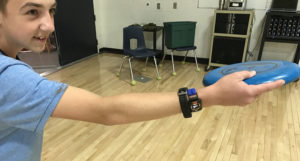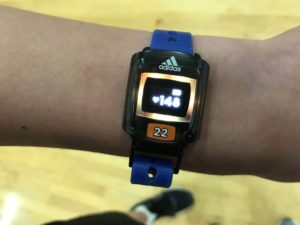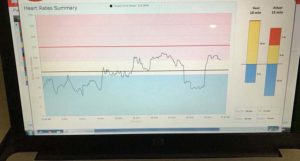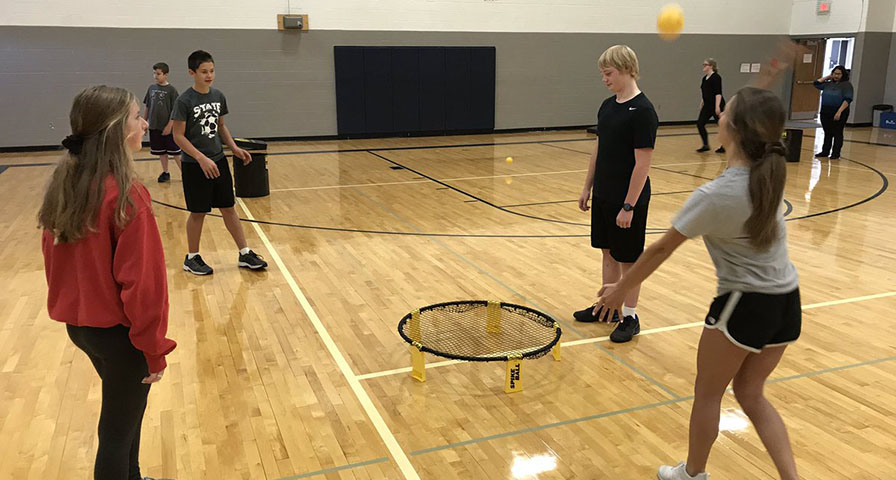Using data collected from the IHT ZONE wrist heart rate monitors his students wear during class, Hudson High School PE (Iowa) teacher Sean Leonard will give students the freedom to personalize his curriculum during the next school year. Rather than participate in Leonard’s preselected daily activity during class, they’ll have the freedom to choose the activity that drives each of them to achieve their daily goals of time spent exercising at an elevated heart rate.
Lessons from an ‘Eye-Opening Experience’
-
Collect heart rate data regularly: Be consistent with the use of heart rate monitors. As students see the technology as part of their routine, the data will be a true reflection of the effort they give.
-
Offer a variety of activities to motivate students of all fitness levels: Heart rate data enables teachers to see exactly how each student performs in relation to their goal. Students will respond differently to each activity. Help students find activities that drive them to meet their daily goal.
-
Challenge students to do their best: The ZONE shows student and teacher in real time how hard the student is working. Each student has their own best, regardless of how fast they run or how high they jump. Reinforce to the class that each student’s best effort is different.
Leonard introduced his students to the IHT ZONE monitors in January to collect daily heart rate session data. The data he’s collected has prompted him to rethink the way he approaches his PE curriculum. From what he has learned so far, he plans to test personalizing his class by letting students choose the fitness activities that motivate them the most.
 “I’m beginning to wonder: does it matter what we do as long as they’re in the [target heart rate] zone for as long as we want them to be?” he said. “If they know how to get there and stay there?”
“I’m beginning to wonder: does it matter what we do as long as they’re in the [target heart rate] zone for as long as we want them to be?” he said. “If they know how to get there and stay there?”
Leonard and his PE colleagues added the IHT Spirit System to their curriculum in January. Their goals:
- Teach students to manage their heart rate
-
- Empower students to exercise at a moderate to vigorous level
- Determine the types of activities that motivate students to stay in their target heart rate zones for a specific amount of time during each 44-minute class.
“Of the 44 minutes, I think we wanted them in their target zones for at least 30-35 minutes,” Leonard said. “I’ll tell you what, they’ve done a really good job and they’re learning what it takes to meet those goals.”
Using 20 Meter Shuttle as a Control Exercise
Leonard began the second semester continuing a tried-and-true curriculum that focused on high-intensity interval training (HIIT). Utilizing HIIT circuits allowed him to keep students moving throughout the class while working on different exercises at each station, but he also used the 20 meter shuttle – or PACER – as a measuring stick to see if students showed fitness improvement.
“Over the course of the semester, the data shows that between 60-65% of the students improved their PACER scores,” he said. “Obviously you’d like to be able to say that 100% of the students improved, but there’s more we need to study about that data.”
Test results aside, Leonard has seen enough instances of individual student improvement to know they are learning how to pace themselves to increase the time they can spend in their target heart rate zones even when they don’t have a heart rate monitor to rely on.
 “They’re learning about pacing and what it takes to get in their zone and then stay in it,” he said. “So when they don’t have these monitors, they have a good idea when they’re working out on their own in the future if their workout is helping them the way they want it to or not.”
“They’re learning about pacing and what it takes to get in their zone and then stay in it,” he said. “So when they don’t have these monitors, they have a good idea when they’re working out on their own in the future if their workout is helping them the way they want it to or not.”
Leonard’s already seen students change their approach to his class. The ZONE monitors have shown some students they need to pick up their pace while reassuring others that they are giving their best effort.
“There are a couple of students in particular who felt like they were athletes and in really good shape,” Leonard said. “They were having a hard time getting into the yellow [heart rate zone]. They always thought that they would get into the zone easily and when they didn’t, that really motivated them and pushed them into a different level.
“And then there are students on the other side who aren’t as fit,” he continued. “They are slower than most students but they are in their target zones and that has helped other students see that even though it doesn’t appear they are working hard, they really are. That’s been helpful for everyone to see, that we are all different. It has been an eye-opening experience.”
Empowered to Transition to a Personalized Learning PE Model
 Leonard’s gone through his own eye-opening lesson. As the final six-week grading period began, he added back some different activities to see if students could keep their heart rates in the target zones.
Leonard’s gone through his own eye-opening lesson. As the final six-week grading period began, he added back some different activities to see if students could keep their heart rates in the target zones.
“We brought some variety to the workouts just to see the effects that different activities would have on heart rate,” he said. “We did some acceleration activities along with tagging games that focused on speed and agility. I can see it’s really been helpful to modify the way we teach our current curriculum.”
Leonard records data from each session, looking to see which activities drive the majority of his students to reach their target heart rate zones and then maintain that effort to achieve their daily goals. The data helps him, but it also helps students understand that fitness isn’t a one-size-fits-all endeavor.
“We just asked them to do their best and understand that everyone else’s best is a little bit different,” he said. “We’re just trying to find out exactly which [activities] are best, and a lot of that work is on the students. They’re able to monitor themselves and their heart rate throughout the entire class.”
While there’s still a great deal of data to study, Leonard’s learning just as much about planning as his students are about exercising at an elevated heart rate.
“It’s really helped me looking at the data initially, just the day-to-day stuff, and making sure that I’m doing my part and giving them every opportunity to make sure that they do get in their zone and they stay in that as long as we would like them to,” he said.
With students demonstrating mastery of the effort required to reach and maintain their target heart rate, Leonard said he’ll make one major change to his teaching philosophy moving forward. Once students consistently reach their goals for minutes of MVPA, he’ll give them the freedom to choose how they get there.
“I’m highly considering just giving them some ownership on what we do,” he said. “They know the activities they really like to do, but [they understand] that we’re still going to get the fitness benefits out of them. The data will really tell us a lot. I’m not sure we have enough yet to set things in stone yet, but we’re getting there.”




